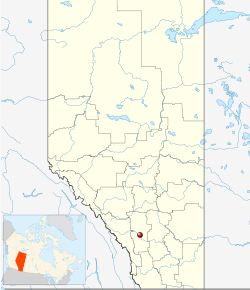- Study in AustraliaAustralian Universities/CollegesPrograms by faculty AusAustralian VisasLife in Australia
- Study In New ZealandNew Zealand UniversitiesPrograms by Faculty NZNew Zealand VisasLife in New Zealand
- Study in CanadaUniversities/Colleges in CANADAPrograms by faculty CanadaCanadian VisasLife in Canada
Calgary
| Calgary | |||
| Calgary is a city in the province of Alberta, Canada. It is located in the south of the province, in an area of foothills and prairie, approximately 80 km (50 mi) east of the front ranges of the Canadian Rockies. The city is located in the grassland and parkland natural regions of Alberta.As of 2011, the City of Calgary had a population of 1,096,833 and a metropolitan population of 1,214,839, making it the largest city in Alberta, and the third-largest municipality and fifth-largest metropolitan area in Canada. While many Calgarians continue to live in the city's suburbs, more central districts such as 17 Avenue, Kensington, Inglewood, Forest Lawn, Marda Loop and the Mission District have become more popular and density in those areas has increasedThe nightlife and the availability of cultural venues in these areas has gradually begun to evolve as a result. | | ||
 | |||
| Calgary is recognized as a Canadian leader in the oil and gas industry as well as for being a leader in economic expansion. Its high personal income, low unemployment and high GDP per capital have all benefited from increased sales and prices due to a resource boom, and increasing economic diversification. Because of these strengths, Calgary is designated as a global city by the Globalization and World Cities Research Network. Also, Calgary was one of the top 200 cities worldwide, by the Brookings Institution, that had a top performing local economy for 2011. The city was ranked first nationally, and 51st in the world, in that aspect Calgary is the site of the Southern Alberta Jubilee Auditorium performing arts, culture and community facility. The auditorium is one of two "twin" facilities in the province, the other located in Edmonton, each being locally known as the "Jube." The 2,538-seat auditorium was opened in 1957 and has been host to hundreds of Broadway musical, theatrical, stage and local productions. The Calgary Jube is the resident home of the Alberta Ballet Company, the Calgary Opera, the Kiwanis Music Festival, and the annual civic Remembrance Day ceremonies. Both auditoriums operate 365 days a year, and are run by the provincial government. Both received major renovations as part of the province's centennial in 2005. The city is also home to a number of theatre companies; among them are One Yellow Rabbit, which shares the EPCOR Centre for the Performing Arts with the Calgary Philharmonic Orchestra, as well as Theatre Calgary, Alberta Theatre Projects and Theatre Junction Grand, culture house dedicated for the contemporary live arts. Calgary was also the birthplace of the improvisational theatre games known as Theatresports. The Calgary International Film Festival is also held in the city annually, as well as the International Festival of Animated Objects. Visual and conceptual artists like the art collective United Congress are active in the city. There are a number of art galleries in the downtown, many of them concentrated along the Stephen Avenue and 17 Avenue corridors. The largest of these is the Art Gallery of Calgary (AGC). Calgary is also home to the Alberta College of Art and Design. Calgary hosts a number of annual festivals and events. These include the Calgary International Film Festival, the Calgary Folk Music Festival, FunnyFest Calgary Comedy Festival, the Folk Music Festival, the Greek Festival, Carifest, Wordfest: Banff Calgary International Writers Festival, the Lilac Festival, GlobalFest, the Calgary Fringe Festival, Summerstock, Expo Latino, Calgary Gay Pride, Calgary International Spoken Word Festival,[45] and many other cultural and ethnic festivals. Calgary's best-known event is the Calgary Stampede, which has occurred each July since 1912. It is one of the largest festivals in Canada, with a 2005 attendance of 1,242,928 at the 10-day rodeo and exhibition. Several museums are located in the city. The Glenbow Museum is the largest in western Canada and includes an art gallery and First Nations gallery. Other major museums include the Chinese Cultural Centre (at 70,000 sq ft (6,500 m2), the largest stand-alone cultural centre in Canada), the Canadian Olympic Hall of Fame and Museum (at Canada Olympic Park), The Military Museums, the Cantos Music Museum and the Aero Space Museum. Downtown can be recognized by its numerous skyscrapers. Some of these structures, such as the Calgary Tower and the Scotia bank Saddle dome are unique enough to be symbols of Calgary. Office buildings tend to concentrate within the commercial core, while residential towers occur most frequently within the Downtown West End and the Beltline, south of downtown. These buildings are iconographic of the city's booms and busts, and it is easy to recognize the various phases of development that have shaped the image of downtown. The first skyscraper building boom occurred during the late 1950s and continued through to the 1970s. After 1980, during the recession, many high-rise construction projects were immediately halted .It was not until the late 1980s and through to the early 1990s that major construction began again, initiated by the 1988 Winter Olympics and stimulated by the growing economy. In total, there are 10 office towers that are at least 150 m (490 ft) (usually around 40 floors) or higher. The tallest of these is The Bow (Encana headquarters), which is the tallest office tower in Canada outside Toronto. Calgary's Bankers Hall Towers are also the tallest twin towers in Canada. Several larger office towers are planned for downtown: Jamieson Place, Eighth Avenue Place (two towers), Centennial Place (two towers), City Centre (two towers), and the highly anticipated (although only rumoured) Imperial Oil and First Canadian Centre II towers. | |||
For more information, please contact one of our offices
Study in Australia | Study in the UK | Study in Malaysia | Study in Canada | Study in the USA | Study in New Zealand

.jpg)













